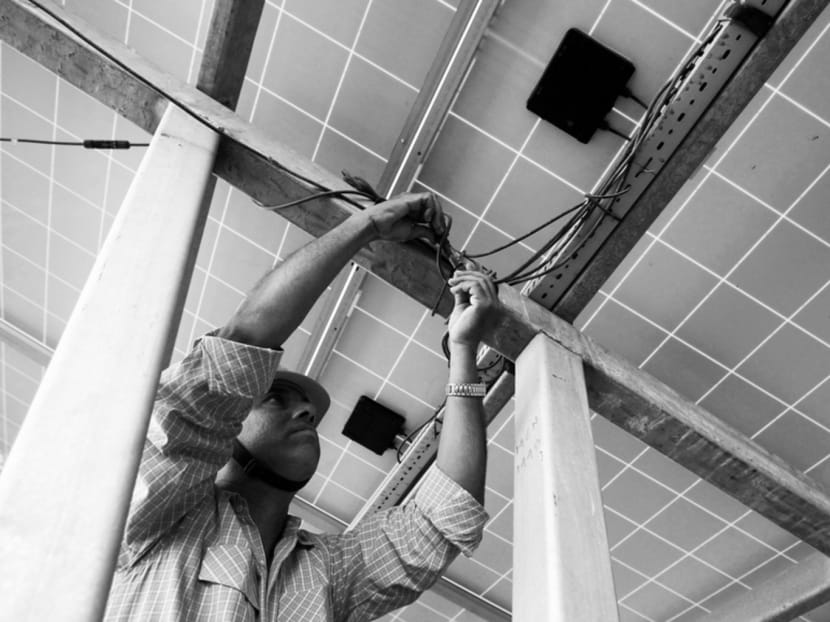India should embrace its climate change opportunity — for its own sake
India lags far behind rival China in wealth and development — and also in the amount of carbon dioxide it spews into the atmosphere. Indian leaders have said this explains why it should not be expected to limit its greenhouse-gas output as China has just done.

An engineer working on solar panels in Gujarat earlier this year. India is well-positioned to benefit from new energy storage and distribution technologies that can bypass the decrepit transmission grid. Photo: Reuters
India lags far behind rival China in wealth and development — and also in the amount of carbon dioxide it spews into the atmosphere. Indian leaders have said this explains why it should not be expected to limit its greenhouse-gas output as China has just done.
At global climate talks in Lima this week, they will probably also point out that one in four Indians still lacks electricity, so the country cannot afford any limits on economic growth.
In fact, India’s relatively low level of development is exactly why it stands to benefit from setting aggressive emissions targets. It means, first, that the country has a chance to build smarter.
One government estimate showed that about 70 per cent of India’s buildings in 2030 would have been constructed after 2011.
Enforcing strict green building codes now, and providing financial and tax incentives to comply, would limit the carbon intensity of India’s growth and, at the same time, improve its air quality and help businesses save money.
In a similar way, the rapid expansion of India’s smaller cities offers an opportunity to upgrade public transportation and avoid productivity-killing gridlock.
Eager to boost India’s manufacturing sector, Prime Minister Narendra Modi has backed plans for new efficient rail freight corridors, an encouraging sign.
If his government also rationalised pricing — traditionally, high freight tariffs have subsidised passenger fares, while diesel subsidies, now lifted, have made road transport artificially cheap — it could enlarge the share of goods shipped by rail, which has fallen to less than a third.
HEALTHIER GROWTH PLAN
For its own reasons, notably India’s poor oil and gas reserves, Mr Modi’s government has set ambitious targets for renewables, hoping to reach 100GW of solar power by 2022, from around 3GW today — a commendably ambitious target.
While that may be a stretch, the country is well-positioned to benefit from new energy storage and distribution technologies that can bypass the decrepit transmission grid.
If Mr Modi continues to eliminate subsidies as he has promised, his government could also invest more in energy research and development, and reduce the country’s dependence on imported (mostly Chinese) green technology.
None of this would end coal’s dominance in India’s energy picture. It will long be the cheapest, and dirtiest, source of power, and the government has laid plans to double state-run Coal India’s output over the next five years.
However, right now, only about 6 per cent of coal-fired power plants use so-called super-critical boiler technologies, which are much cleaner than older systems. As new plants come online between now and 2030, that proportion could be pushed to more than 50 per cent.
Upping the existing coal tax and expanding it to other fossil fuels would also make clean energy more economically viable. Bigger investments in nuclear and hydropower projects could raise the proportion of energy generated by non-fossil fuels to a third by 2030.
Committing to these strategies —say, by setting more ambitious targets for reducing carbon intensity, if not emissions — will not be cheap. Indeed, it could knock 0.15 per cent off annual growth, a government estimate showed, if India gets no outside financial support for the effort. But the investment will pay long-term dividends, and it is a cost India cannot afford to dodge.
With its long coastline and huge population (1.25 billion and counting), the country is worryingly vulnerable to flooding and other effects of climate change. And the costs of India’s air pollution — by some measures worse than China’s — in terms of lost lives, healthcare and potential political tensions are certain to rise. India should consider this week’s talks an opportunity to set itself on a healthier growth path — for its own sake, no less than the world’s. BLOOMBERG






